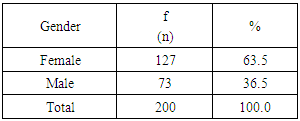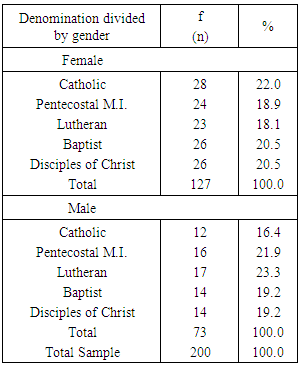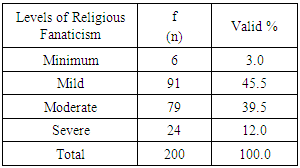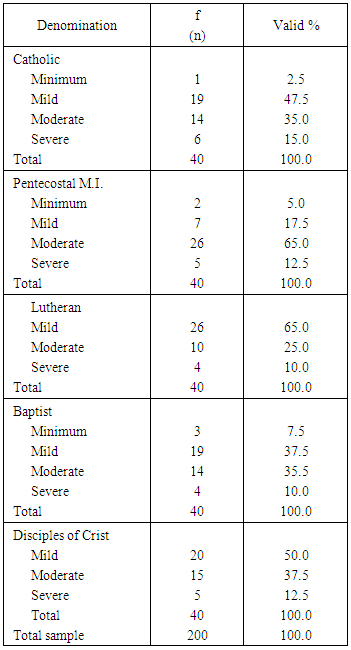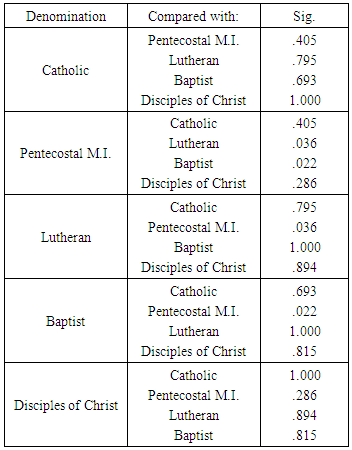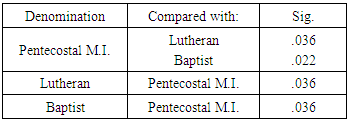-
Paper Information
- Next Paper
- Paper Submission
-
Journal Information
- About This Journal
- Editorial Board
- Current Issue
- Archive
- Author Guidelines
- Contact Us
International Journal of Psychology and Behavioral Sciences
p-ISSN: 2163-1948 e-ISSN: 2163-1956
2018; 8(4): 59-64
doi:10.5923/j.ijpbs.20180804.01

Religious Fanaticism in Puerto Rico: An Interdenominational Pilot Study
Eledy E. Cintrón-Vázquez1, José R. Rodríguez-Gómez1, 2
1Albizu University, San Juan Campus, San Juan, Puerto Rico
2UPR, Medical Sciences Campus, School of Medicine, San Juan, Puerto Rico
Correspondence to: Eledy E. Cintrón-Vázquez, Albizu University, San Juan Campus, San Juan, Puerto Rico.
| Email: |  |
Copyright © 2018 The Author(s). Published by Scientific & Academic Publishing.
This work is licensed under the Creative Commons Attribution International License (CC BY).
http://creativecommons.org/licenses/by/4.0/

This is a pioneer research whose main goal is to explore the levels of religious fanaticism with an adult sample of five different religious denominations in Puerto Rico using a pioneer scale entitled Religious Fanaticism Scale (RFS). Two hundred adults from both genders between the ages of 21-86 years old from five religious denominations: Catholics, Protestants (i.e. Lutheran, Baptist), and Evangelical in Puerto Rico (i.e., Christian Disciples Church and International Mission (MI) Pentecostal Church. In addition, some psychometrics properties of the RFS was evaluated, obtaining an alpha Cronbach of 0.89 (adequate according to Kline) [1]. All participants were administrated the RFS, Beck’s Depression Inventory (BDI-II) and Beck’s Anxiety Inventory (BAI). The results demonstrated via ANOVA analysis that there were statistically significant differences between the levels of religious fanaticism among the religious denominations in Puerto Rico. Pentecostal MI and Lutheran account for higher level of religious fanaticism in this particular sample. No statistical differences were obtained within the denominations in terms of depression or anxiety. Lower significant correlations (0.016) between religious fanaticism and anxiety were found in all denominations. It is suggested to increase denominational sampling and to incorporate other religious denominations.
Keywords: Religious Fanaticism, Puerto Ricans, Depression, Anxiety, Spirituality, Religious Aspects, Puerto Rico
Cite this paper: Eledy E. Cintrón-Vázquez, José R. Rodríguez-Gómez, Religious Fanaticism in Puerto Rico: An Interdenominational Pilot Study, International Journal of Psychology and Behavioral Sciences, Vol. 8 No. 4, 2018, pp. 59-64. doi: 10.5923/j.ijpbs.20180804.01.
1. Introduction
- Religion is an important aspect for the Puerto Rican population. Puerto Rican society has been strongly influenced by organized religion [2]. The scientific literature has pointed out the importance of religion for the physical and mental health [2]. On the other hand, models and functions provided by religious traditions help to build the “self” and respond to the need for identity and self-esteem of individuals, forming a construction of identity [3]. According to Ubarniak a religious believer is defined as the one who internalizes (that is discovers, accepts and interprets), as well as externalizes (understands, gives an existential form) the divine order [4]. Therefore, religious beliefs refer to beliefs about faith, the supernatural and the sacred or divine, which leads to the worship of a deity or deities and can also refer to values and practices based on ideological models of a spiritual leader [5].Fundamentalism must be understood as a category by itself which originated in the early twentieth century through American Protestantism, and which gained popularity in the last quarter of the century of demarcate a distinctive mark of the world religious revival [6]. The term fundamentalism was coined in the early twentieth century when a series of professors a small collection of twelve volumes published in Chicago [7]. Fundamentalism appears when a sense of threat is experienced: certain individuals feel that something or someone is attacking them and there is no alternative but to defend themselves by counterattacking [7]. Also, Urbaniak states that when the established norms and codes are followed blindly, an excuse is generated to judge and condemn others, becoming a means to achieve absolute control over religious aspects [4].The term fanaticism is derived from the Latin fanum or temple, which was used by Cicero [8]. The fanatic term is derived from the Latin word fanaticus, which means “to be put into rabid enthusiasm by a deity” [9]. A fanatic is a person who is not open to reason, someone who instead of using the logic of an argument uses the use of authority and arbitrariness [10]. On the other hand, any types of religious beliefs encourage intolerance, arrogance, prejudice and contempt towards other human beings [11]. Many people with spiritual/religious beliefs, when engaging in traumatic or stressful events, fall into a whirlwind of extremely painful and distressing spiritual struggles that could affect the quality of life of people at a psychiatric level [11]. However, healthy religious attitudes encourage self-growth, self-empowerment and self-actualization [12]. For Quinceno et al. strategies of religious and existential coping can help people to cope with chronic diseases over time and, consequently, spiritual-religious coping can improve the quality of life, provide psychological well-being, happiness, positive emotions, decrease levels of anxiety, depression and addictive and suicidal behaviors [5].The literature points out that there is a relationship between depression and religious practice, although it has been little studied in the general world so far [13]. Therefore, the exploration of the possible role of religion in the mediation of depressive symptomatology is supremely important as an alternative for the psychological treatment of prevention of this disease [13]. In 2005 Perez et al, conducted a study that found a significant negative correlation between the level of depression and actively belonging to a religious or spiritual group, both in the sample of men and women [13]. In addition, they found that the level of depression in women is significantly higher than men, and that religious practice as a form of social support is also significantly more used by women. However, Camacho, Gonzalez, Buelna, Emory, Talavera, Castañeda, & Issasi performed a multinomial logistic regression analysis that showed a significant difference in the class of anxious depression present in the Hispanic/Latino background groups after controlling age, gender, language of preference education and income. In this study, it was found that individuals of Puerto Rican origin had greater prevalence of anxious-depressive symptomatology compared to individuals from Mexico [14]. Nevertheless, the literature is very conservative in mentioning religious fanaticism and its influence on mental health. Taking into consideration the literature and responding to a limited intensification of research studies in this subject, this research will try to bring some insight as to how a sample of Puerto Rican adults can present levels of religious fanaticism associated with depression or anxiety. On the other hand, it is important to recognize Kenneth Gergen’s Constructionist Perspective and the Cognitive Model of Aaron Beck as important theories/models that promotes an understanding of how subject’s religious constructions can affect obedience [15, 16]. Furthermore, is important to mention that religious constructions can provides personal schemas that help to develop religious obedience to leader ideas, without questioning them. Moreover, Aaron Beck Cognitive Model, also provides information of how individuals created such schemas, in such way they affect their behaviour.Hypothesis:H1: It is expected that the Evangelical denominations (Pentecostal Church M.I.) will show significant statistical differences of p<.05, higher levels of religious fanaticism as measured by the instrument entitled Religious Fanaticism Scale in comparison with other religious denominations. H2: It is expected that people with high scores in religious fanaticism will show a statistically significant (pH3: It is expected to observe statistically significant differences (p<.05) between the Catholic, Evangelical and Protestant denominations.H0: There will be no statistically significant differences (p<.05) between the Catholic, Evangelical and Protestant denominations.
2. Method
- Participants: The research was approved by an Institutional Review Board (IRB) to protect participants and certify as adequate all research procedures. Two hundred adults (63.5% women and 36.5% men) were selected by availability between the ages of 21-86 years old from five different denominations: Catholics, Pentecostal M.I., Baptist, Lutheran and Disciples of Christ. The sample was a non-probabilistic and selected by availability. The availability sample procedure enclosed those adults who assent to participate in the research, but also those whose consented to participate in a voluntary base. Investigation design: A quantitative study of non-experimental design of an exploratory-correlational nature. A non-experimental exploratory correlation study describes variables and analyses the interrelation at a given moment. Thereby, the phenomenon can be observed as it occurs in its natural context, to later analyse them.Procedures and Instruments: Sociodemographic Questionnaire: Socio-demographic questionnaire date sheet contained questions related to the life of the participant, which was used to obtain general socio demographic information. This form examined aspects on age, education, gender, religious denomination, among others. Religious Fanaticism Scale: A preliminary version of the Religious Fanaticism Scale (20 items) was developed by Rodriguez-Gomez (2017) for a previous study in Puerto Rico; the study evaluate the levels of religious fanaticism of four protestant denominations. An alpha Cronbach (α) of .79 was obtained in that occasion [17]. This initial version aims to measure the levels of religious fanaticism in terms of following the suggestions, or requirements, of their religious leader without questioning. The instrument used to measure the levels of religious fanaticism was answered using a four-point Likert scale composed of the following options; 4=totally agree, 3=partially agree, 2=partially disagree and 1=totally disagree. A higher score was given to those statements represent religious fanaticism; in this way, a higher score account for a higher fanatic attitude towards the religious leader requests. As related to this current study, the original scale created by Rodriguez Gomez [17] was evaluated to explore the Cronbach’s alpha (α) with a new sample (n=200) and five other protestant denominations in Puerto Rico. The final version reflect, after running factor analysis with this particular sample (n=200), a 14 items scale, with an alpha Cronbach of 0.89, which meets Kline’s criteria for an adequate alpha (greater than or equal to 0.70) [18]. Beck Depression Inventory: The Beck Depression Inventory (BDI-II) is “a 21 item self-report instrument to measure the severity of depression in adults and adolescents from thirteen years onwards” [16]. The inventory score is the total sum of the scores of the 21 items, therefore, it ranges from a minimum of 0 to a maximum of 63. The administration manual suggests as a guide values from 0 to 13 as minimum depression, from 14 to 19 as mild depression, from 20 to 28 as moderate depression and from 29 to 63 as severe depression [16]. Beck Anxiety Inventory: It is a “21-item scale that measures the severity in adults and adolescents” [15]. The suggested values range are from 0 to 7 for minimal anxiety, from 8 to 15 for mild anxiety and from 26 to 63 for severe anxiety [19]. General Procedures: The investigation began by locating the five denominations and obtaining the ecclesiastic’s permission. Once the churches were chosen by availability, an appointment with the priests was made. The letters and the consents required for the study were drafted. Each of the letters contained the explanation, authorization and the objectives of the investigation. Once the priests gave their authorization the study began by informing the congregation through o consent letter. It included the names of the investigator and supervisor, the study’s objectives, the inclusion and exclusion criteria, confidentiality right’s and the potential risks of the investigation, among other topics. It also contained the socio-demographic questionnaire. The information corresponding to the date, place and time that the study will take place, was informed to the participants by the priests and by means of flyers. On various dates, the investigator went to the churches authorized to collect the consent of the participants and administering the instruments. Once the date was obtained, the investigator created a data bank using statistical software SPSS-X version 2.1. Statistical Analysis: An Alpha level of 0.5 was used for all quantitative data analysis. Descriptive statistics such as: mean, median, frequency and standard deviation were performed to explore distribution of socio-demographic characteristics of the participants. In addition, inferential statistics were also used, such as intra-group correlations by age and gender. The Spearman Correlation techniques were used to establish the comparisons. Furthermore, an Analysis of Variance of a Factor (ANOVA) was carried out with the purpose of comparing religious groups in a quantitative variable.
3. Results
- The sample (N=200) was divided by age ranges, where the greatest number of participants was between the ages of 54-64 years old (n=55). According to the information provided, most of the participants in this study were women (n=127). Table 1 presents the distribution of gender in the sample, while the table 2 shows the distribution of gender for each religious denomination.
|
|
|
|
|
|
|
|
|
|
4. Discussion
- The present study has been analyzed by Kenneth Gergen’s Constructionist Perspective and the Cognitive Model of Aaron Beck. [15, 16] Both models contribute to the understanding of religion as a social construct and its influence on the psychological aspects. Given the results of this study, we must recognize that religion accompanies man and society as a basic element of the composition of the individuals and their identity. Therefore, the constructionism proposes an alternative perspective to the individual approach of knowledge, allowing to analyze the role played by a community’s shared knowledge and how they reproduce their reality [20]. On the other hand, these results are consistent with the literature reviewed. According to Appleby, fundamentalism was originated in the early twentieth century through American Protestantism. This explains the results obtained in this study where the Protestants groups (Lutherans and Baptists) showed significant levels of religious fanaticism since these institutions share an historical background in terms of their origin because they’re both historical churches.Berrios, Rodriguez and Quintero conducted an exploratory study on the risks factors of religious abuse among parishioners of three religious denominations in Puerto Rico: Catholic Church, Presbyterian and Church of God Mission Board, which belongs to the Pentecostal movement [21]. Their study showed significant differences between the groups (F=4.776) at a significance level of 0.010. After performing a post-hoc analysis, it was found that there are significant differences between the Presbyterian and Mission Board churches, as well as between the Catholic and Presbyterian churches. These results conclude that the members of the Catholic and Mission Board churches reported a significantly higher number of factors of religious abuse than members of the Presbyterian church [21]. Indeed, this study helps us to understand the results of the present study of religious fanaticism obtained by the Pentecostal Church, which showed significant differences in their levels of religious fanaticism in comparison with the other denominations.Furthermore, it is imperative to consider the influence of religious beliefs in relation to mental health. With regards to the constructionist theoretical framework, the role played by conceptions and characteristics gives us a certain element to comprehend the way in which identity is constructed [22]. In this study it was found that there were no significant differences between the religious denominations under and their levels of depression or anxiety. This is consistent with the literature that supports religiosity as a positive factor in psychological well-being. According to Lavrič & Flere, in highly religious cultural contexts, one might expect psychological well-being to correlate positively with general religiosity and even more with intrinsic religious orientation [23]. More importantly, spirituality provides significant benefits in the psychological well-being of people because religion plays a general protective role against suicide [24].In contrast, religion is like medicine: proper use leads to health and, on the contrary, reckless use can lead to death [25]. For this reason, we can say that the results obtained through the Spearman correlation showed that excessive use and lack of critical analysis can cause the person to be a religious fanatic, which can lead to the development of anxiety. According to the theoretical framework of constructivism, the human being creates and actively constructs their personal reality [26]. Consequently, general beliefs can alter the perception of specific situations that individuals may encounter on daily basis [16].
5. Limitations
- In this study we understand the results were the product of the variable religious denomination of each participant. There are other variables that can affect the execution of people when answering any type of questionnaire. Such as, environmental and/or motivational factors. The principal investigator administrated the instruments as determined with the religious leader of each Church. In some cases, the instrument was administered during the morning before the religious celebration and in others at the end of the celebration. Therefore, the time and moment of answering the instruments can affect their mood and their internal state of each person to complete the instruments. The concentration and attention of the participants can be affected by external factors such as hunger or fatigue, which is understandable after a morning of religious celebration.
6. Recommendations
- It is recommended to use the results of this exploratory study for future research. In the future this study could be repeated including other religious denominations and a larger number of participants. In Puerto Rico there are many religious denominations additionally to the five groups under study. Therefore, it would be beneficial to administer this scale to other denominations. In fact, it should be administered to independent churches that do not belong to any council recognized at Puerto Rico. These churches have the freedom to establish their own norms, which is why religious fanaticism could arise among those denominations.
 Abstract
Abstract Reference
Reference Full-Text PDF
Full-Text PDF Full-text HTML
Full-text HTML